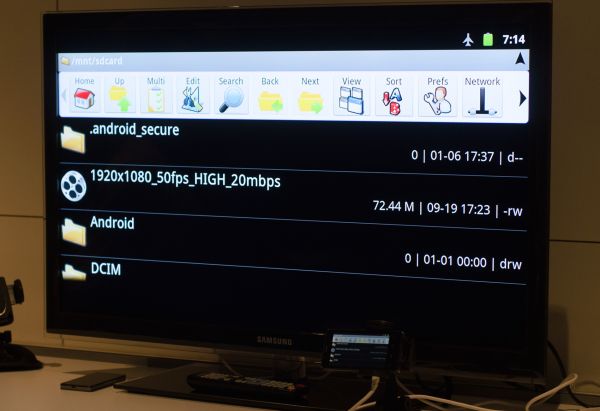Intel's Medfield & Atom Z2460 Arrive for Smartphones: It's Finally Here
by Anand Lal Shimpi on January 10, 2012 8:00 PM ESTThe GPU
The PowerVR SGX 540 in Medfield is no different from what you'd get in an OMAP 4460, with the exception that it's clocked a bit higher at 400MHz.
The SGX 540 here is a remnant of Intel's earlier strategy to have Medfield out far sooner than it actually is going to show up on the market. Thankfully Intel has plans to introduce a PowerVR SGX 543MP2 based Medfield successor also before the end of the year.
Video Decode/Encode Support, Silicon Hive ISP
Intel relies on two more IP blocks from Imagination Technologies: the VDX385 and VDE285 for 1080p video decode and encode. Intel claims support for hardware accelerated 1080p30 decode, High Profile. Maximum supported bitrate is apparently up to 50Mbps, although Intel only demonstrated a 20Mbps High Profile stream:
Intel also claims support for 1080p30 video encode.
Medfield's ISP is provided by Intel owned Silicon Hive. The ISP supports cameras ranging from 5MP to 16MP (primary sensor), with the reference design standardizing on an 8MP sensor. Medfield supports burst capture at up to 15 fps (8MP).
The Process
Intel bifurcated its process technology a few years ago, offering both low power and high performance versions of each of its process nodes. Today those process nodes are staggered (45nm LP after high perf 32nm, 32nm LP debuts after high performance 22nm, etc...) however Intel plans on bringing both in lockstep.
Medfield debuts on Intel's 32nm LP process. The only details we have from Intel are that leakage is 10x lower than the lowest on 45nm. Compared to Moorestown, Medfield boasts 43% lower dynamic power or 37% higher frequency at the same power level.
The bigger and more valid comparison is to TSMC's 28nm process, which is what companies like Qualcomm will be using for their next-generation SoCs. It's unclear (and very difficult) to compare different architectures on different processes, but it's likely that Intel's 32nm LP process is more comparable to TSMC's 28nm LP process than it would be to any 4x-nm node.
It is important to note that Intel seems very willing to sacrifice transistor density in order to achieve lower power consumption where possible. I don't believe Intel will have the absolute smallest die sizes in the market, but I also don't believe it's clear what the sweet spot is for mobile SoCs at this point. It's quite likely that Apple's ~120mm^2 target is likely where everyone will eventually end up in the near term.
The Roadmap
Although Medfield is already posting competitive performance numbers, its current competition is roughly a year old. Within the next two quarters we'll see smartphones and tablets shipping based on Qualcomm's Krait. The next-generation Snapdragon platform should be Cortex A15-like in its performance level
Today we have Medfield, a single core Atom paired with a PowerVR SGX 540 built on Intel's 32nm LP process. Before the end of the year we'll see a dual-core Atom based Medfield with some form of a GPU upgrade. I wouldn't be too surprised to see something like a PowerVR SGX 543MP2 at that point either. In tandem Intel will eventually release an entry level SoC designed to go after the more value market. Finally we'll see an Intel Atom based SoC with integrated Intel baseband from its Infineon acquisition - my guess is that'll happen sometime in 2013.











164 Comments
View All Comments
french toast - Sunday, January 15, 2012 - link
You dumbass, cant you see it has got nothing to do with that, its the VERSION that the phones run on and then compared against...2.3.7 is much faster than 2.3.3 or 2.3.4..to make it an equal fair test you would have to run EQUAL software.You would also have to do a number of different tests that stress the cpu under LOAD, then measure the power consumption.
Anand has taken some very biased intel run power slides and benched these phones on limited single thread benchmarks, and yes it shows an advantage, BUT that could just be the android version its self, not representitive of medfield superiority.
Add to that the fact that Atom runs alot faster per core and only slightly beats old hardeware on such single thread tests like caffeinemark, and looses others on quadrant and antutu, as well as offering worse gpu performance than a galaxy s2, note, and iphone 4s that were released mid last year on 40nm.
Krait on 28nm with on die 4g in quadcore configuerations and with a next gen 320 gpu will release THIS year about the time Intel releases a chip that is barley competitive with chips LAST year.
baros - Monday, January 16, 2012 - link
Why didn't intel go with meego instead ?diulaylomochohai - Wednesday, April 25, 2012 - link
Why did the battery test omit numbers from HTC 1S and 1X?jaffa62 - Wednesday, May 16, 2012 - link
Typical smartphone malware leverages platform vulnerabilities that allow it to gain root access on the device in the background. Using this access the malware installs additional software to target communications, location, or other personal identifying information. Thanks.Regards,
http://www.scottsdale-azsearchforhomes.com/scottsd...